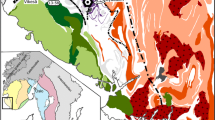Abstract
Zircon and monazite from granulite- to amphibolite-facies rocks of the Vosges mountains (central Variscan Belt, eastern France) were dated by ion-microprobe and conventional U-Pb techniques. Different granulites of igneous (so-called leptynites) and sedimentary origin (kinzigites) and their leucosomes were dated at 334.9 ± 3.6, 335.4 ± 3.6 and 336.7 ± 3.5 Ma (conventional age 335.4 ± 0.6 Ma). Subsequent growth stages of zircon were distinguished by secondary electron (SEM) and cathodoluminescence (CL) imaging: (1) subsolidus growth producing round anhedral morphologies and sector zoning; (2) appearance of an intergranular fluid or melt phase at incipient dehydration melting that first resulted in resorption of pre-existing zircons, followed by growth of acicular zircons or overgrowths on round zircons consisting of planar growth zoning; (3) advanced melting producing euhedral prismatic zircons with oscillatory zoning overgrowing the sector zones. Two further lithologies, the Kaysersberg granite and the Trois-Epis units, were both formerly considered as migmatites. The intrusion of the Kaysersberg granite was dated at 325.8 ± 4.8 Ma. The Trois-Epis unit was found to be the product of volume recrystallization of a former granulite, which occurred under amphibolite-facies conditions 327.9 ± 4.4 Ma ago. The amphibolite-facies overprint of the Trois-Epis zircons led to the complete rejuvenation of most of the zircon domains by annealing and replacement/recrystallization processes. Annealing is assumed to occur in strained lattice domains, which are possibly disturbed by high trace element contents and/or large differences in decay damage between adjacent growth zones. Investigation of cathodoluminescence structures reveals that the replacement occurs along curved chemical reaction fronts that proceed from the surface towards the interior of the zircon. The monazite U-Pb system still records the age of high-grade metamorphism at around 335 Ma. The chemical reagent responsible for the rejuvenation of zircon obviously left the monazite unaffected.
Similar content being viewed by others
Author information
Authors and Affiliations
Additional information
Received: 19 February 1998 / Accepted: 19 October 1998
Electronic Supplementary Material
Rights and permissions
About this article
Cite this article
Schaltegger, U., Fanning, C., Günther, D. et al. Growth, annealing and recrystallization of zircon and preservation of monazite in high-grade metamorphism: conventional and in-situ U-Pb isotope, cathodoluminescence and microchemical evidence. Contrib Mineral Petrol 134, 186–201 (1999). https://doi.org/10.1007/s004100050478
Published:
Issue Date:
DOI: https://doi.org/10.1007/s004100050478



